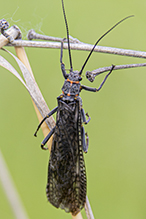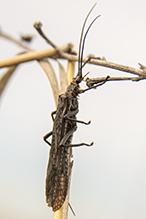Midwestern salmonfly
(Pteronarcys pictetii)
Conservation • Description • Habitat • Ecology • Distribution • Taxonomy
Conservation Status |
|||
| IUCN Red List | not listed |
||
| NatureServe | N5 - Secure SNR - Unranked |
||
| Minnesota | not listed |
||
Description |
Midwestern salmonfly is a large, dark brown, giant stonefly. It is common in the Midwest from Minnesota and Wisconsin south to Kansas and Indiana. Adults are 1½″ to 2½″ long. The body is soft, elongated, and flattened. The head is rounded in front, narrows slightly in the rear, and has a thin, bright orange, rear margin. There are two large compound eyes at the side of the head and three simple eyes (ocelli) in a triangle on top of the head in the middle. The antennae are long and thread-like, and have many segments. The mouthparts are vestigial. The exoskeletal plate covering the thorax (pronotum) is highly sculptured. It is dark brown with a thin, bright orange, longitudinal stripe in the middle. There are also three bright orange spots at the base. There is a pair of sensory appendages (cerci) at the end of the abdomen. There are two pairs of membranous wings. The hindwings fold flat over the body fan-like and cover most of the abdomen. It has many prominent veins and a large anal lobe. The forewings are narrower and longer than the hindwings. It also has many prominent veins, including a series of cross veins between the media vein (M) and the cubitus vein (Cu) and between the first cubitus vein first branch (Cu1) and second branch (Cu2). The are also two rows of two rows of cross veins in the anal area and a row of cross veins between the costa (C), the vein at the leading edge of the wing, and the subcosta (Sc). The third segment (femur) and fourth segment (tibia) of each leg is robust. There is a pair of claws at the end of each leg. |
Size |
Total length: 1½″ to 2½″ |
Similar Species |
Habitat |
Cool, small to medium-sized streams |
Ecology |
Season |
April to June |
Behavior |
Nymphs move very slowly. When disturbed they will pretend to be dead. Adults are poor fliers and when disturbed they will run rather than fly away. They are sometimes found far from water. They are active at night (nocturnal) and are attracted to lights. |
Life Cycle |
Nymphs live in well aerated water and take 2 to 3 years to develop. Adults emerge from April to June and live for only 2 to 3 weeks. |
Nymph Food |
Particulate plant matter |
Adult Food |
Adults do not feed |
Distribution |
||
|
Sources Stoneflies of the United States; U.S. Geological Survey (archived) |
|
| 8/27/2025 | ||
Occurrence |
||
Common |
||
Taxonomy |
|
Order |
Plecoptera (stoneflies) |
Suborder |
Arctoperlaria |
Infraorder |
Systellognatha |
Superfamily |
Pteronarcyoidea |
Family |
Pteronarcyidae (giant stoneflies) |
Subfamily |
Perlodinae |
Tribe |
Perlodini |
Genus |
Pteronarcys (giant stoneflies and salmonflies) |
Subordinate Taxa |
|
|
|
Synonyms |
|
|
|
Common Names |
|
midwestern salmonfly |
|
Glossary
Cercus
One of a pair of small sensory appendages at the end of the abdomen of many insects and other arthropods. In Odonata, one of the upper claspers. Plural: cerci.
Femur
On insects and arachnids, the third, largest, most robust segment of the leg, coming immediately before the tibia. On humans, the thigh bone.
Ocellus
Simple eye; an eye with a single lens. Plural: ocelli.
Pronotum
The exoskeletal plate on the upper side of the first segment of the thorax of an insect.
Tibia
The fourth segment of an insect leg, after the femur and before the tarsus (foot). The fifth segment of a spider leg or palp. Plural: tibiae.
Visitor Photos |
Share your photo of this insect. |
||
This button not working for you? |
||
|
||
MinnesotaSeasons.com Photos |
 |
 |

Slideshows |
|

Visitor Videos |
Share your video of this insect. |
||
This button not working for you? |
||
|
Other Videos |
|

Visitor Sightings |
Report a sighting of this insect. |
||
This button not working for you? |
||
|
|
MinnesotaSeasons.com Sightings |

|
Created: 6/8/2019 Last Updated: © MinnesotaSeasons.com. All rights reserved. |
